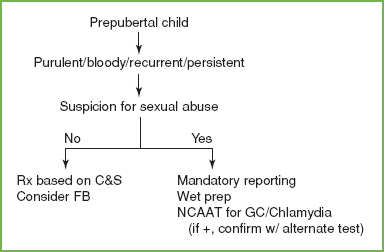VAGINAL DISCHARGE
JENNIFER H. CHUANG, MD, MS AND KAREN J. DIPASQUALE, DO, MPH
Vaginal discharge among children and adolescents is a common complaint, and the differential diagnosis can be very broad. Discharge may be physiologic as a normal part of development, or it may be infectious and require further testing and treatment. Physiologic leukorrhea, a clear or whitish discharge is caused by circulating estrogen that stimulates the vaginal epithelium. This can be seen in newborns up to 3 weeks of age, the discharge resolves spontaneously as the effects of maternal estrogen wane. It also occurs before menarche, due to an increase in circulating estrogen levels.
Vaginal discharge beyond the newborn period and prior to puberty is an abnormal finding. Appropriate treatment is guided by history, physical examination, laboratory testing, and imaging if needed. The possibility of sexual abuse must always be considered in any girl presenting with vaginal complaints.
Postpubertal females presenting with vaginal discharge usually have a specific cause, including sexually transmitted infections, candidiasis, bacterial vaginosis, or physiologic leukorrhea (see Chapter 100 Gynecology Emergencies).
EVALUATION OF VAGINAL DISCHARGE IN THE PREPUBERTAL CHILD
Differential Diagnosis
The etiology of vaginal discharge in the prepubertal child differs from that of the adolescent (Figure 76.1). Normal vaginal flora in this age group may contain Staphylococcus epidermidis, Streptococcus viridans, diphtheroids, mixed anaerobes, enterococci, lactobacillus, and Escherichia coli. Lack of estrogen in the prepubertal child results in thinner, atrophic labia and an alkaline pH, making the vaginal mucosa more susceptible to irritation and infections. This is potentiated by the higher prevalence of poor local hygiene, the close proximity to the rectum, more frequent use of bubble baths and other harsh soaps, the use of tight, nonabsorbent clothing, and exploratory behaviors with insertion of foreign bodies in this age group.
Vaginitis is the most common gynecologic problem in prepubertal girls, and the differential diagnosis can be quite extensive (Table 76.1). In addition to vaginal discharge, other symptoms can include dysuria, itching, soreness, erythema, and bleeding.
Nonspecific vaginitis occurs in 25% to 75% of girls presenting with symptoms of vaginal discharge. In these cases, no specific pathogen is isolated. The etiology is most likely the result of poor perineal hygiene or mechanical or chemical irritation. Symptoms resolve within 2 to 3 weeks with vaginitis treatment.
Children with infection caused by respiratory and enteric pathogens often present with a purulent, bloody, or mucoid discharge. The most common respiratory pathogen associated with this infection is Streptococcus pyogenes. A recent history of sore throat is often obtained. Other bacteria found less commonly include Staphylococcus aureus, nontypable Haemophilus influenzae, Streptococcus pneumoniae, Neisseria meningitides, and Moraxella catarrhalis. Enteric pathogens that may or may not be associated with diarrhea include Shigella flexneri and Yersinia enterocolitica.
The possibility of sexual abuse must always be considered in a child who presents with vaginal complaints. Sexually transmitted infections in this age group most commonly result from sexual abuse and include Neisseria gonorrhoeae, Chlamydia trachomatis, Trichomonas vaginalis, human papilloma virus, and herpes simplex virus.
N. gonorrhoeae infection causes a purulent vaginal discharge. C. trachomatis may produce a scant, mucoid discharge, but is often asymptomatic. Chlamydia may be transmitted perinatally and may persist for several months until 3 years of age. However, the possibility of sexual abuse must be thoroughly investigated as it is more common. T. vaginalis infection beyond the newborn period is transmitted through sexual contact. Vaginal discharge and other vaginal symptoms are often mistakenly diagnosed as candidal infections in prepubertal girls. In contrast to the postpubertal adolescent, candidal infection in the prepubertal child typically causes perineal dermatitis rather than vaginal discharge and vulvar inflammation. Candidal vulvovaginitis infections are not common in the prepubertal child, and if present, most often occur in those children who are immunosuppressed or who have had recent antibiotic treatment.
Foreign bodies in the vagina usually present with a foul-smelling discharge and/or bleeding. Other presenting symptoms may include dysuria and vaginal, pelvic, or abdominal pain. The most common items retained are toilet paper, hair accessories, toys, and paper clips, although any object that is small enough to pass through the introitus has the potential to be an intravaginal foreign body.
An ectopic ureter, which can originate from a duplex collecting system or from a dysplastic kidney, and can insert into or near the vagina, can cause chronic symptoms of vulvar irritation, wetness, and a purulent discharge in prepubertal girls. A history of chronic vaginal discharge and recurrent urinary tract infections should increase the examiner’s index of suspicion for this diagnosis.
Other causes of vaginal complaints in the prepubertal child include cervical polyps and tumors, systemic illnesses such as Kawasaki disease and Crohn’s, certain infectious diseases including scarlet fever and some viral illnesses, parasitic diseases such as pinworms, and skin diseases such as atopic dermatitis, contact dermatitis, and lichen sclerosis.
TABLE 76.1
DIFFERENTIAL DIAGNOSIS OF VAGINITIS IN THE PREPUBERTAL CHILD


FIGURE 76.1 Diagnostic approach to vaginal discharge.
Examination
Stay updated, free articles. Join our Telegram channel

Full access? Get Clinical Tree







